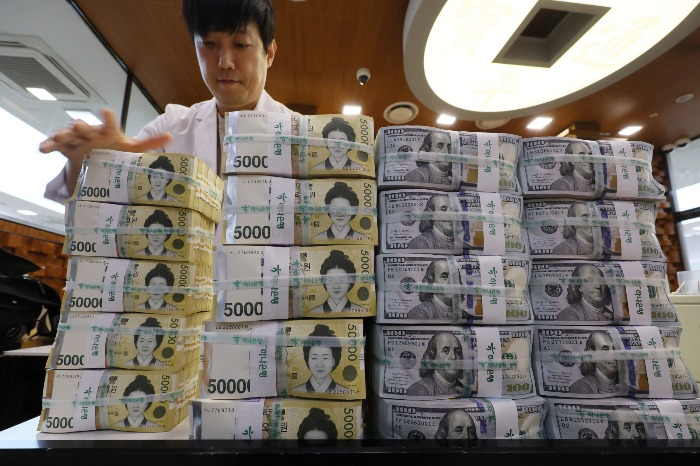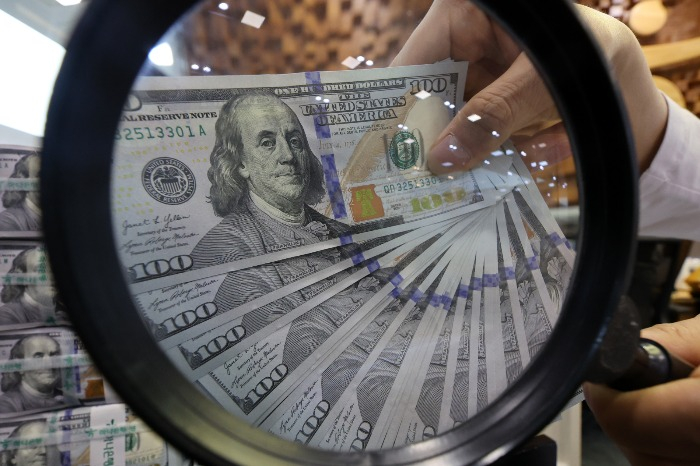Foreign exchange
South Korea returns to US FX monitoring watchlist
The US Treasury Department cited Korea's sufficient current account surplus and trade surplus with the US as reasons for reinstating the status
By Nov 15, 2024 (Gmt+09:00)
3
Min read
Most Read
LG Chem to sell water filter business to Glenwood PE for $692 million


Kyobo Life poised to buy Japan’s SBI Group-owned savings bank


KT&G eyes overseas M&A after rejecting activist fund's offer


StockX in merger talks with Naver’s online reseller Kream


Mirae Asset to be named Korea Post’s core real estate fund operator



The United States has reinstated South Korea on its foreign-exchange monitoring watchlist, a year after it removed Asia’s No. 4 economy from the list.
Korea was put back on the list because the country met two of the three criteria set by the US Trade Facilitation and Trade Enforcement Act of 2015, according to the US Treasury Department's semiannual report on the macroeconomic and foreign exchange policies of major US trading partners released on Thursday.
On Friday, Korea’s Ministry of Economy and Finance explained that Korea was returned to the list because its bilateral trade surplus with the US exceeded $15 billion, and the country’s current account surplus surpassed 3% of its gross domestic product (GDP).
The third criterion is persistent, one-sided intervention in the foreign currency market for at least eight months of a year, with net purchases totaling at least 2% of an economy's GDP over a 12-month period.
None of the countries on the US FX monitoring watchlist, however, including Korea, manipulated the exchange rate between its currency and the US dollar “for purposes of preventing effective balance of payments adjustments or gaining unfair competitive advantage in international trade,” the report said.
China, Japan, Taiwan, Singapore, Vietnam and Germany have been on the list since June 2024.
Korea was taken off the list in November 2023 for the first time in seven years and stayed off it in June this year because the country only met one criterion: an excessive trade surplus with the US.

As of end-June, Korea’s annualized current account surplus took up 3.7% of the country’s GDP due to a significant increase in the country’s current account surplus from July 2023 to June 2024, on the back of a higher goods surplus driven by strong global demand for Korean tech goods, according to the Treasury Department’s report.
It also said Korea’s trade surplus with the US had jumped to $50 billion from $38 billion over the same period.
EXCUSE FOR MEASURES TO NARROW KOREA’S TRADE SURPLUS
Any adverse effects of Korea’s return to the FX monitoring watchlist are expected to be limited, but concerns are growing that President-elect Trump would use Korea’s bigger trade surplus with the US as an excuse to pressure Korea into narrowing it.
“Considering that, against US concerns, Korea sold US dollars to prevent a fall in its currency value, it is unlikely the US would take any extra measures” that are discriminatory toward Korea, said Jeong Young-sik, executive director of the International Macroeconomics and Finance department at the Korea Institute for International Economic Policy (KIEP).
“But the (new) US administration could use it as an excuse to narrow Korea’s trade surplus with the US," he added.

Korea’s return to the US FX monitoring watchlist comes as the country’s currency grapples with a freefall in value against the greenback.
The US dollar has gained strength against a basket of major currencies following the re-election of Donald J. Trump as US president, who has pledged to slap high tariffs on imports and slash taxes.
The greenback has rapidly strengthened against the Korean won over the past week, hitting the psychologically important 1,400 won mark this week.
On Thursday, Korea’s Finance Minister Choi Sang-mok issued the country’s first verbal intervention over excessive volatility in the won-dollar exchange rate since April, when the won briefly touched 1,400 per dollar in response to escalating geopolitical tensions in the Middle East.
Since May, the won regained ground against the dollar and hovered around 1,300 per dollar.
Choi’s verbal intervention, however, failed to stop the won's slide.
The Korean government net-sold $9 billion worth of US dollars, accounting for 0.5% of the country’s GDP, from July 2023 to June 2024 to prevent the won’s slide.
The won/dollar rate ended at 1,406.40 on Friday versus 1,407.30 on Thursday.
Write to Se-Min Huh at semin@hankyung.com
Sookyung Seo edited this article.
More to Read
-
 EconomyS.Korea’s current account at near 7-year high on strong chip exports
EconomyS.Korea’s current account at near 7-year high on strong chip exportsAug 07, 2024 (Gmt+09:00)
3 Min read -
 Foreign exchangeKorean won hits 15-year low in Q2 amid FX, economic uncertainty
Foreign exchangeKorean won hits 15-year low in Q2 amid FX, economic uncertaintyJul 07, 2024 (Gmt+09:00)
5 Min read -
 Foreign exchangeNavigating choppy waters: Dollar-won FX forecasting
Foreign exchangeNavigating choppy waters: Dollar-won FX forecastingApr 26, 2024 (Gmt+09:00)
3 Min read -
 EconomyS.Korea’s current account surplus near 3-year high on chips
EconomyS.Korea’s current account surplus near 3-year high on chipsApr 05, 2024 (Gmt+09:00)
1 Min read -
 Foreign exchangeKorean exporters suffer FX derivate losses on weak won
Foreign exchangeKorean exporters suffer FX derivate losses on weak wonNov 17, 2022 (Gmt+09:00)
3 Min read
Comment 0
LOG IN


